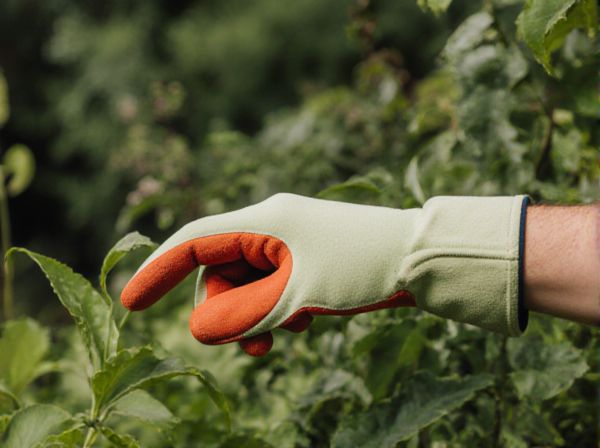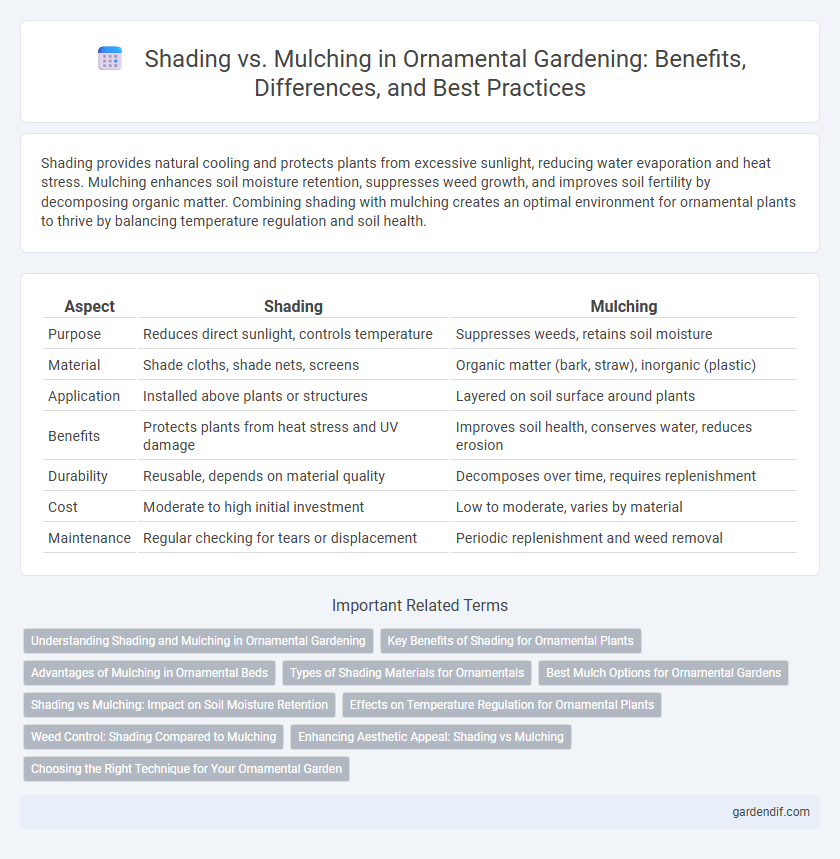
Shading vs Mulching Illustration
Shading provides natural cooling and protects plants from excessive sunlight, reducing water evaporation and heat stress. Mulching enhances soil moisture retention, suppresses weed growth, and improves soil fertility by decomposing organic matter. Combining shading with mulching creates an optimal environment for ornamental plants to thrive by balancing temperature regulation and soil health.
Table of Comparison
| Aspect | Shading | Mulching |
|---|---|---|
| Purpose | Reduces direct sunlight, controls temperature | Suppresses weeds, retains soil moisture |
| Material | Shade cloths, shade nets, screens | Organic matter (bark, straw), inorganic (plastic) |
| Application | Installed above plants or structures | Layered on soil surface around plants |
| Benefits | Protects plants from heat stress and UV damage | Improves soil health, conserves water, reduces erosion |
| Durability | Reusable, depends on material quality | Decomposes over time, requires replenishment |
| Cost | Moderate to high initial investment | Low to moderate, varies by material |
| Maintenance | Regular checking for tears or displacement | Periodic replenishment and weed removal |
Understanding Shading and Mulching in Ornamental Gardening
Shading in ornamental gardening involves strategically placing plants or structures to reduce direct sunlight exposure, protecting delicate foliage and flowers from UV damage. Mulching enhances soil moisture retention, regulates temperature, and suppresses weeds, creating an optimal environment for ornamental plants to thrive. Combining effective shading with proper mulching techniques promotes healthier growth and vibrant blooms in landscaped gardens.
Key Benefits of Shading for Ornamental Plants
Shading provides essential temperature regulation for ornamental plants, reducing heat stress and preventing leaf scorch during intense sunlight exposure. It enhances moisture retention by minimizing soil evaporation, promoting healthier root systems and sustained growth. Shading also protects delicate flowers and foliage from UV damage, preserving vibrant colors and extending bloom longevity.
Advantages of Mulching in Ornamental Beds
Mulching in ornamental beds enhances soil moisture retention, reducing the frequency of watering and promoting healthier plant growth. It suppresses weed growth by blocking sunlight, minimizing competition for nutrients and improving bed aesthetics. Mulch also regulates soil temperature, protecting delicate roots from extreme heat and cold, resulting in more vibrant and resilient ornamental plants.
Types of Shading Materials for Ornamentals
Shading materials for ornamentals vary from natural options like bamboo mats and palm fronds to synthetic fabrics such as polyethylene shade cloth and knitted polyester netting. Each type offers different levels of UV protection, air permeability, and durability, influencing plant growth and microclimate regulation. Choosing the right shading material enhances ornamental plant health by reducing heat stress and controlling light intensity.
Best Mulch Options for Ornamental Gardens
Organic mulches like shredded bark, pine needles, and composted leaves are among the best mulch options for ornamental gardens due to their ability to retain moisture, suppress weeds, and improve soil fertility. Inorganic mulches such as landscape fabric and decorative stones provide long-lasting weed control and aesthetic appeal but do not enhance soil health. Choosing mulch materials based on plant type, local climate, and garden design ensures optimal growth and visual harmony in ornamental landscapes.
Shading vs Mulching: Impact on Soil Moisture Retention
Shading significantly reduces soil temperature and evaporation rates, enhancing soil moisture retention by limiting direct sunlight exposure. Mulching creates a protective barrier on the soil surface, reducing evaporation and moderating soil temperature fluctuations. Both shading and mulching improve soil moisture retention but achieve this through different mechanisms--shading by limiting solar radiation and mulching by insulating the soil surface.
Effects on Temperature Regulation for Ornamental Plants
Shading reduces soil and ambient temperature by blocking direct sunlight, creating a cooler microclimate essential for heat-sensitive ornamental plants. Mulching insulates the soil, stabilizing temperature fluctuations by retaining moisture and reducing heat loss during colder periods. Together, these methods optimize thermal conditions, promoting healthy growth and preventing stress in ornamental landscapes.
Weed Control: Shading Compared to Mulching
Shading effectively suppresses weed growth by limiting sunlight, which inhibits photosynthesis essential for weed development. Mulching also provides a physical barrier that reduces weed emergence by blocking light and maintaining soil moisture, but it may require replenishment as organic materials decompose. Compared to mulching, shading offers a more immediate and mechanical method of weed control, particularly beneficial in ornamental landscapes where reducing chemical herbicide use is desired.
Enhancing Aesthetic Appeal: Shading vs Mulching
Shading enhances ornamental garden aesthetics by creating dynamic light and shadow contrasts that highlight plant textures and colors, offering a natural and soothing ambiance. Mulching improves visual appeal through uniform ground cover, suppressing weeds, and adding rich, earthy tones that complement floral arrangements. Both techniques contribute uniquely to garden beauty, with shading emphasizing vertical visual interest and mulching enhancing horizontal surface uniformity.
Choosing the Right Technique for Your Ornamental Garden
Selecting the right technique for your ornamental garden depends on factors like plant type, soil condition, and climate. Shading protects delicate foliage from intense sunlight and prevents heat stress, crucial for shade-loving species. Mulching conserves soil moisture, suppresses weeds, and improves organic matter, benefiting flower beds and shrub borders.
Shading vs Mulching Infographic

 gardendif.com
gardendif.com